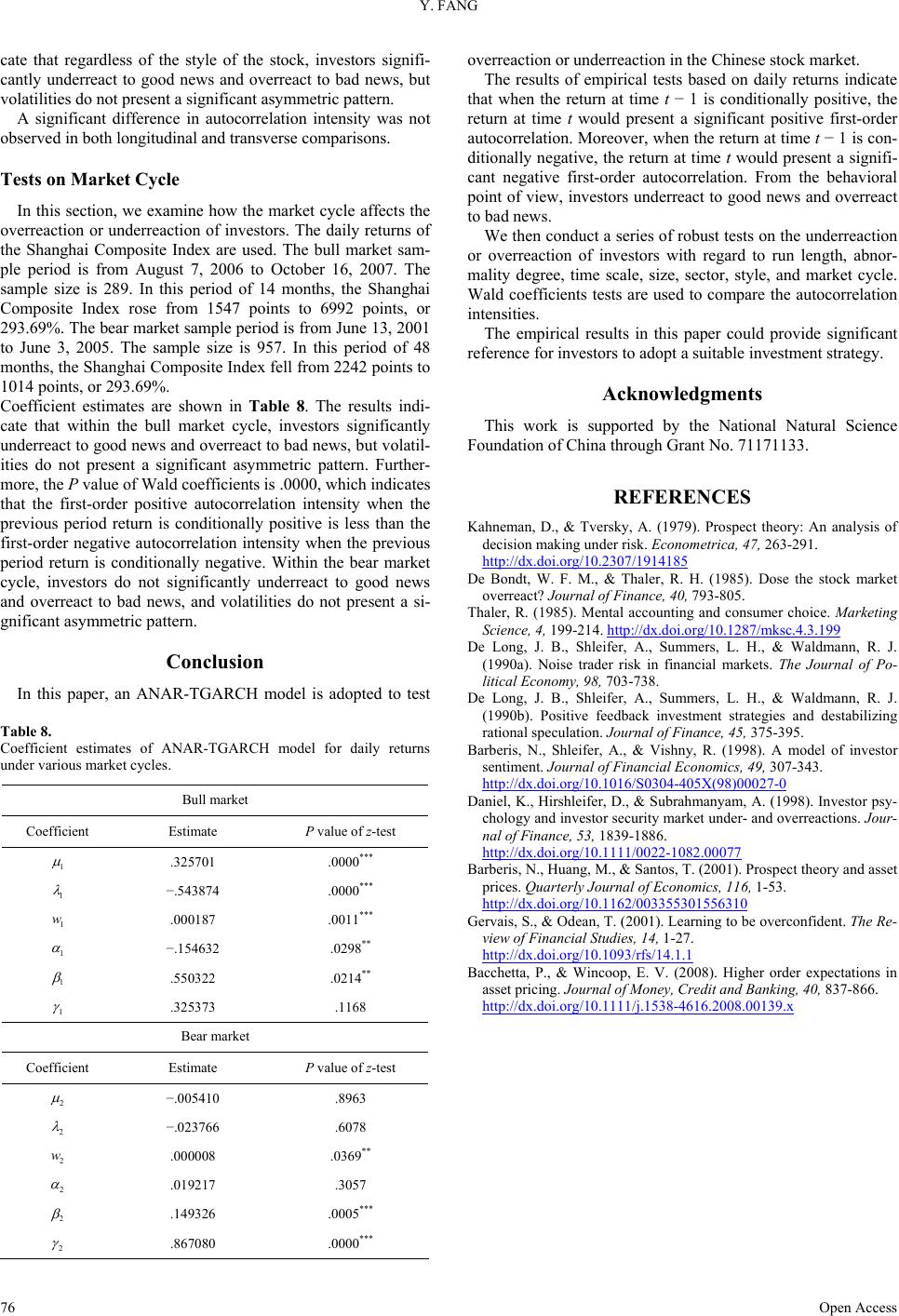
Y. FANG
Open Access
76
cate that regardless of the style of the stock, investors signifi-
cantly underreact to good news and overreact to bad news, but
volatilities do not present a significant asymmetric pattern.
overreaction or underreaction in the Chinese stock market.
The results of empirical tests based on daily returns indicate
that when the return at time t − 1 is conditionally positive, the
return at time t would present a significant positive first-order
autocorrelation. Moreover, when the return at time t − 1 is con-
ditionally negative, the return at time t would present a signifi-
cant negative first-order autocorrelation. From the behavioral
point of view, investors underreact to good news and overreact
to bad news.
A significant difference in autocorrelation intensity was not
observed in both longitudinal and transverse comparisons.
Tests on Market Cycle
In this section, we examine how the market cycle affects the
overreaction or underreaction of investors. The daily returns of
the Shanghai Composite Index are used. The bull market sam-
ple period is from August 7, 2006 to October 16, 2007. The
sample size is 289. In this period of 14 months, the Shanghai
Composite Index rose from 1547 points to 6992 points, or
293.69%. The bear market sample period is from June 13, 2001
to June 3, 2005. The sample size is 957. In this period of 48
months, the Shanghai Composite Index fell from 2242 points to
1014 points, or 293.69%.
We then conduct a series of robust tests on the underreaction
or overreaction of investors with regard to run length, abnor-
mality degree, time scale, size, sector, style, and market cycle.
Wald coefficients tests are used to compare the autocorrelation
intensities.
The empirical results in this paper could provide significant
reference for investors to adopt a suitable investment strategy.
Acknowledgments
Coefficient estimates are shown in Table 8. The results indi-
cate that within the bull market cycle, investors significantly
underreact to good news and overreact to bad news, but volatil-
ities do not present a significant asymmetric pattern. Further-
more, the P value of Wald coefficients is .0000, which indicates
that the first-order positive autocorrelation intensity when the
previous period return is conditionally positive is less than the
first-order negative autocorrelation intensity when the previous
period return is conditionally negative. Within the bear market
cycle, investors do not significantly underreact to good news
and overreact to bad news, and volatilities do not present a si-
gnificant asymmetric pattern.
This work is supported by the National Natural Science
Foundation of China through Grant No. 71171133.
REFERENCES
Kahneman, D., & Tversky, A. (1979). Prospect theory: An analysis of
decision making under risk. Econometrica, 47, 263-291.
http://dx.doi.org/10.2307/1914185
De Bondt, W. F. M., & Thaler, R. H. (1985). Dose the stock market
overreact? Journal of Finance, 40, 793-805.
Thaler, R. (1985). Mental accounting and consumer choice. Marketing
Science, 4, 199-214. http://dx.doi.org/10.1287/mksc.4.3.199
De Long, J. B., Shleifer, A., Summers, L. H., & Waldmann, R. J.
(1990a). Noise trader risk in financial markets. The Journal of Po-
litical Economy, 98, 703-738.
Conclusion
In this paper, an ANAR-TGARCH model is adopted to test De Long, J. B., Shleifer, A., Summers, L. H., & Waldmann, R. J.
(1990b). Positive feedback investment strategies and destabilizing
rational speculation. Journal of Finance, 45, 375-395.
Table 8.
Coefficient estimates of ANAR-TGARCH model for daily returns
under various market cycles.
Bull market
Coefficient Estimate P value of z-test
1
.325701 .0000***
1
−.543874 .0000***
1
w .000187 .0011***
1
−.154632 .0298**
1
.550322 .0214**
1
.325373 .1168
Bear market
Coefficient Estimate P value of z-test
2
−.005410 .8963
2
−.023766 .6078
2
w .000008 .0369**
2
.019217 .3057
2
.149326 .0005***
2
.867080 .0000***
Barberis, N., Shleifer, A., & Vishny, R. (1998). A model of investor
sentiment. Journal of Financial Economics, 49, 307-343.
http://dx.doi.org/10.1016/S0304-405X(98)00027-0
Daniel, K., Hirshleifer, D., & Subrahmanyam, A. (1998). Investor psy-
chology and investor security market under- and overreactions. Jour-
nal of Finance, 53, 1839-1886.
http://dx.doi.org/10.1111/0022-1082.00077
Barberis, N., Huang, M., & Santos, T. (2001). Prospect theory and asset
prices. Quarterly Journal of Economics, 116, 1-53.
http://dx.doi.org/10.1162/003355301556310
Gervais, S., & Odean, T. (2001). Learning to be overconfident. The Re-
view of Financial Studies, 14, 1-27.
http://dx.doi.org/10.1093/rfs/14.1.1
Bacchetta, P., & Wincoop, E. V. (2008). Higher order expectations in
asset pricing. Journal of Money , Credit and Banking, 40, 837-866.
http://dx.doi.org/10.1111/j.1538-4616.2008.00139.x